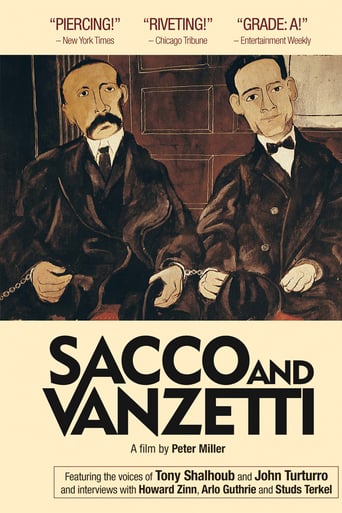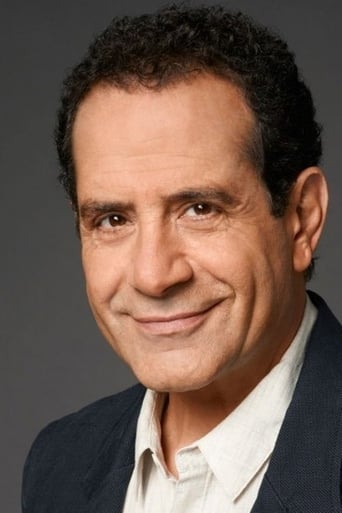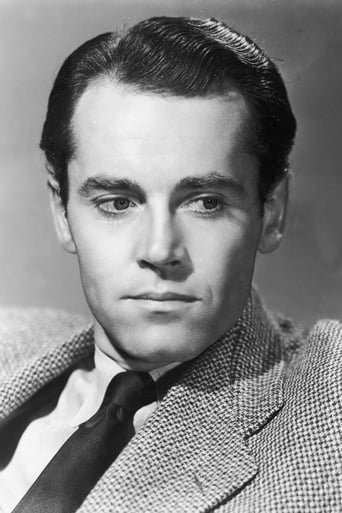

Sacco and Vanzetti (2006)
SACCO AND VANZETTI is an 80-minute-long documentary that tells the story of Nicola Sacco and Bartolomeo Vanzetti, two Italian immigrant anarchists who were accused of a murder in 1920, and executed in Boston in 1927 after a notoriously prejudiced trial. It is the first major documentary film about this landmark story.
Watch Trailer
Cast
Reviews
Wonderful Movie
Excellent, Without a doubt!!
Entertaining from beginning to end, it maintains the spirit of the franchise while establishing it's own seal with a fun cast
If the ambition is to provide two hours of instantly forgettable, popcorn-munching escapism, it succeeds.
I had only discovered the case a few years. As two Italian anarchists and radicals were really executed for their beliefs rather than the two murders of a payroll master and guard that despite being very brutal.Still the case has been an example and if you can say a role model for other cases like this to come in the present and future. As if both Sacco and Vanzetti did this or not. Or if they were caught in the wrong place and at the wrong time.It shows Sacco as a family man and Vanzetti as a hard working fish peddler. Both were trying to make a living in America. Until they were put into history that they did not ask for.Their case involves workers rights, the rights for immigrants among the topics. As this case should be studied for all history to come!
Sacco and Vanzetti were innocent beyond any doubt, their trials and appeals were shams, and they are rightfully folk heroes to all the oppressed. That is the message of this unbalanced documentary where on person (maybe) thinks they committed the crime for which they died, and then she is apparently ignorant of the facts. In response to the interviewer's question (I paraphrase), do you think they murdered your father, the daughter of one of the victims says (again I paraphrase), well, someone killed him. That's the lone voice for guilt. This despite the fact that many historians and legal scholars think one or both are guilty, and many others have considerable doubt about their complete innocence.If you know a good bit about the case this documentary will make you feel uneasy. The lionization of S&V is over the top. And considering that it is quite likely Sacco was involved, if not Vanzetti, and if not in these crimes in aiding and abetting other violent crimes, the exaltation of the men as heroes is unsettling. Why S&V are such symbols of the miscarriage of justice, given the evidence, I cannot explain. Better to sing songs, write poems, and create art about the thousands of southern black martyrs. But maybe that is why liberal, white Americans (and all of the S&V apologists in this film are white) latch on to S&V. A study of the dichotomy between the outrage (contemporaneous and modern)displayed by liberal whites over S&V and the relative indifference to the numerous lynching cases might be interesting. Not tot say that liberal whites condone lynching, but it is interesting that the S&V case is such a lightning rod for them in contrast. That said, there is no question their trial and appeals were horribly biased and unfair. That is what has always appalled me about the case. This is covered a good bit in the documentary. Rightfully, the commentators hold the judge and jury in disdain. This is well presented. The evidence by which we might independently judge the guilt of S&V, though, is terribly one sided here and highly selective and speculative.
Long before Amy Fisher and Joey Buttafucco became household names and courtroom celebrities, long before Robert Blake and O.J. Simpson took to the stand in their own defense, there were Ferdinando Nicola Sacco and Bartolomeo Vanzetti, two Italian immigrants whose highly-publicized murder trial electrified the nation and became one of the hot media sensations of the 1920's.Shortly after coming to America, both Sacco and Vanzetti became involved with a group of socialist anarchists dedicated to eradicating (sometimes through the use of violence) the stark inequities of status and class they perceived in the society around them (an idea that did not go down well in a capitalist nation watching in horror the success of the then quite recent Bolshevik Revolution). On April 15, 1920, the pair was arrested for the murder of two men, a paymaster and a security guard, who were shot in cold-blood while transporting the payroll from a shoe factory in Braintree, Massachusetts. Even though there was no real evidence tying them to the killings, Sacco and Vanzetti were eventually placed on trial, convicted on charges of 1st degree murder, and put to death in the electric chair on August 23, 1927. In the years since, the case of Sacco and Vanzetti has gone down in history as one of the major miscarriages of justice in all of American jurist prudence, while their very names have become synonymous with a legal system that too often abandons its quality of disinterested objectivity in favor of bigotry, corruption and fear.As directed by Peter Miller, the documentary "Sacco and Vanzetti" attempts to come to terms with the fate of the two men and to view the case in its broader social context. Through the use of archival photos and footage, interviews with experts and historians (and even a niece of Sacco himself), clips from the 1971 movie dramatization of the story, "Sacco and Vanzetti," and voice-over recitations of excerpts from the two key figures' very own journals and letters, Miller explores how the legal system was able to veer so far off the rails in a country that prides itself on the blindness of its justice and the fair treatment it ostensibly affords to all its people. He finds his answer mainly in the love/hate relationship that America has always had with its immigrant populations. For he makes it clear that this was little more than a sham show trial, one consisting mainly of circumstantial evidence and fraudulent testimony, presided over by a judge with small tolerance for immigrants or anyone not of the Anglo-Saxon persuasion. The men were found guilty more of the sin of being "unpatriotic" than of the commission of any actual crime. It is this aspect, more than any other, that touched such a raw nerve in so many people not only in the United States but around the world. Towards the end, we are shown how the case eventually moved beyond its own limited context, entering the realm of American mythology and inspiring socially conscious artists, poets, novelists and songwriters to produce some of their most poignant and notable work.Although the movie is a bit murky on some of the facts of the case and doesn't offer us a clear enough picture of the men as individuals (the pre-crime period in their lives is particularly sketchy), "Sacco and Vanzetti" provides us with an interesting history lesson as well as an intriguing glimpse into the time in which the events took place. In addition, with its tale of racial discrimination and societal prejudice, the movie has a great deal of relevance for the world today as we see immigration once again coming to the forefront as a hot-button political issue, a parallel the filmmakers are quick to point out at the conclusion of the film. That alone makes this a movie well worth checking out.
Having studied art history, Ben Shahn's iconic portrait of Nicola Sacco and Bartolomeo Vanzetti was what first sparked my interest in Peter Miller's documentary on the notorious case that perverted American justice to enact xenophobic retribution on two anarchist Italian immigrants in a jingoistic, postwar culture of fear (sound familiar? Director Miller certainly seems to think so.) The short, "American Experience"-style presentation (talking heads, dramatic underscore, car trips to sites whose history has long been paved over) does not deflect from the riveting nature of the story as it happened, nor does it protect the audience from squirming at the implications of the awkward reality of American justice in general and the death penalty in particular. (As one of the commentators in the film states, the American legal system may be better designed than any other in the world, but as it is practiced, it is hardly immune to human error.) And, as demonstrated by hundreds of thousands of protesters around the world during the 1920s, the Sacco and Vanzetti case (if it can even be called that, so flimsy was the evidence and how biased the judge and jury) was among the great injustices inflicted by an American courts. By framing the story as he does, first by depicting Sacco and Vanzetti as hard-working idealists (gun-toting anarchists to be sure, but NICE gun-toting anarchists) and sketching out the wary American mood at the time (it wasn't all Jazz Age bootleg hooch and the Charleston, apparently), Miller keeps the audience interested in the outcome of the the ensuing "trial" (the details of which, with the mysteriously-scratched bullet and perjuring witnesses, are the most riveting part of the film, but unfortunately only a tangent from the main message). Disappointingly little attention is paid to the global outcry (tantalizing film clips of protests around the world are shown), and the conventional "where are they now?" epilogue is not included as a part of the movie. And we never do find out more about those Ben Shahn portraits. The inclusion of excerpts from Sacco and Vanzetti's eloquent correspondence, as read in thick accents by Tony Shalhoub and John Turturro, is a nice touch. Overall, the documentary is insightful--and inciteful, and should be mandatory viewing for all high-school U.S. history classes, or for anyone who has an interest in where America has been and where we are going. I'm not convinced, however, that its format makes for riveting cinema-- it would be a much better fit for television.


